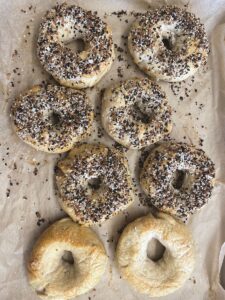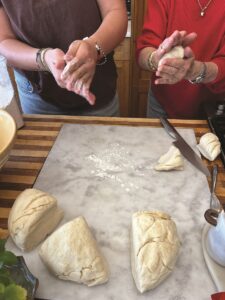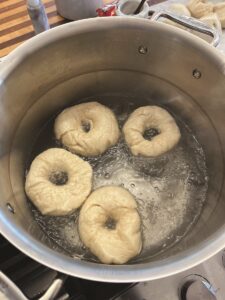The Upper West Side in New York City, where I grew up, is a well-known bagel pilgrimage zone. I know all the stops on the tour.
Near the northern end of the neighborhood, on Broadway between 106th and 107th, is Absolute Bagels, a cash-only joint that serves up the most perfectly fluffy-yet-hefty bagels to be found in the tri-state area and possibly the world. Toasting a fresh one would be criminal. Zabar’s, that erstwhile Jewish deli behemoth further south, is praised for its babka and rugelach but still turns out a highly efficient bagel, good enough to cosset a thick swipe of whitefish or some other meaty spread. Zucker’s, a Tribeca transplant, makes sandwiches on compact hand-rolled bagels. Get the tangy pumpernickel. Then there’s Barney Greengrass, capital of the sturgeon kingdom, where the springy bialy is the smart move.

The Upper West Side is also home to several unassuming shops with the word “bagel” in their names, none of which would show up on any national publication’s best-of list but all of them worthy utility players. Ever since I left the city for college five years ago, it’s these rounds of chewy, holey dough I find myself yearning for.
Like any good New York Jew, I firmly and unabashedly hold the belief that my city’s bagels are the best in the world, rising above the rival fiefdoms of over-shmeared New Jersey and malted Montreal. But honestly, above a certain threshold of quality, I’ll take any bagel I can get my hands on. The accessibility, the proliferation, the ritual of the thing is what I miss.
Facing life in bagel deserts of varying severity, I’ve learned to make a remarkably New York-esque bagel at home. But let’s get something out of the way: I suspect that without a professional kitchen, it’s nearly impossible to recreate the experience of a springy, smoking-hot bagel fresh from an Amsterdam Avenue oven. Bagel shops hold their tips and tricks close to the chest, and none of them has ever trusted me with its secrets.
The homemade bagel, I’ve found, is a humbler creature. Less perfectly rounded. Smaller. At least mine are smaller, maybe because while many recipes call for bread flour, which would strengthen the rise, I stubbornly use the all-purpose flour I have on hand.

But even in its modesty, a bagel conjured from scratch provides an unparalleled rush. It also makes you the most popular person in town, until the batch runs out. The dough freezes well, so I advise making extra and breaking out a few balls whenever you want to lure friends for brunch.
The key to a true bagel is boiling, then baking. The shaped rounds go into a steaming pot of water (the “bagel kettle”) for 90 seconds on each side before they’re laid out on the baking sheet, brushed with an egg wash, and coated with whatever toppings your heart desires. The result is the defining bagel texture: crunchy on the outside and fluffy on the inside.
I make a basic recipe, although experimenting with flourishes like dissolving honey in the bagel kettle is on my to-do list. Some use a dough mixer, but I think hand-kneaded is best. I make the hole with my finger, which I think preserves structural integrity better than the snake method.
Skeptics will raise the perennial question of whether New York’s bagels (and pizza) are elevated by the just-so quality of the city’s “soft” tap water from upstate. The argument goes that low levels of minerals like magnesium and calcium mean weaker gluten structures and thus softer dough. Why would anyone in another watershed even try?

Though I’m a passionate defender of New York’s sublime-tasting tap water, I have two rebuttals to this. First, see above: what you’re making here is a humbler creature, a different animal. I’m under no illusions about how my bagels stack up against the best of the best. But it’s apples to oranges. The sheer joy of making bagels in your own kitchen is the reason to try.
I’m also not convinced that the provenance of your water really matters that much. I’ve made these in New York, Massachusetts, and New Zealand. One of these is not like the others, obviously. But controlling for human error, they have all tasted more or less the same.
Look no further than the Outer Cape’s own Bagel Hound, which churns out chewy and flavorful hand-rolled bagels on Route 6 in Wellfleet and now on Commercial Street in Provincetown, for proof that good bagels can be made on Cape Cod. Thanks to them, I’ve made this recipe only once since I moved here in January — not out of necessity, but for the fun of baking them with Dale and Dave Rheault, my wonderful Wellfleet hosts this spring.
Homemade Bagels
16 bagels
Editor’s note: an earlier version of this story put the yield at only 8 bagels. That’s only true if you freeze half the dough, as the writer did, for baking another 8 later on. Freeze the dough after making the balls in step 5 of the recipe. Later, thaw the balls at warm room temperature and proceed with shaping the bagels.
8 cups all-purpose flour (7 for the dough, 1 for kneading)
4½ tsp. active dry yeast
3 tsp. salt
1 egg
9 tsp. granulated sugar
1½ cups lukewarm water
A little oil or oil spray to coat the bowl
Poppy or sesame seeds, salt, or “everything seasoning” for topping
- Proof your yeast: Add the yeast and 2 ½ teaspoons of sugar to a half cup of lukewarm water, stir briefly to mix, then let it sit for five minutes. You should see bubbles on the surface and notice an increase in volume.
- In a large bowl, combine 7 cups flour and the salt. Make a well in the center of the bowl and gently pour in the yeast mixture plus an additional cup of lukewarm water. Turn the dry ingredients into the wet ingredients inside the bowl until a shaggy dough starts forming. You can add splashes of lukewarm water as you go if it’s not quite hanging together. Once the dough comes together enough to grasp all at once, take it out of the bowl and start kneading on a floured surface.
- Clean and dry the bowl and lightly coat it with oil. Return your dough to the bowl and cover with a wet towel. Put bowl away, ideally in a warm place: an oven turned on for two minutes and then off again works well. Let rise for one hour. After an hour, or when it’s roughly doubled in size, punch down the dough. Cover again and let rise for another 15 minutes.
- Once the dough has risen, return it to a lightly floured surface. This is a good time to fill a large stockpot with water and bring it to a boil. And preheat the oven to 425° F.
- Divide dough into 8 equal pieces and roll them into balls. Press a floured finger into the center of the ball to make a hole. To enlarge the hole, swing the bagel around your finger like a hula hoop. This is also just fun.
- Drop bagels into the boiling water, leaving enough room for them to move around — I usually do two batches of four. After 90 seconds, flip bagels over and let them boil for another 90 seconds.
- Place boiled bagels on a baking sheet. Whisk egg and a touch of water together. Brush egg wash on bagels. Sprinkle your crunchy toppings (poppy or sesame seeds, salt, “everything seasoning”) generously over them.
- Bake for 20 minutes, rotating the pan after 10. Bake until light golden brown. Let cool for at least one minute before serving.



